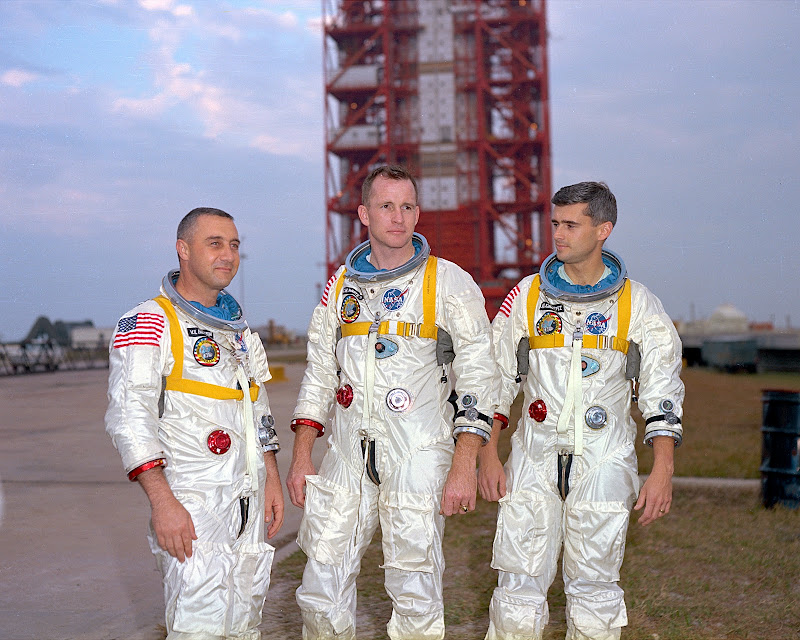
STS-107 crew; in front are (left to right) Payload Specialist Ilan Ramon, Pilot William “Willie” McCool and Mission Specialist David Brown. Standing in back are (left to right) Payload Commander Michael Anderson, Mission Specialist Kalpana Chawla, Commander Rick Husband and Mission Specialist Laurel Clark
8:44:09am, February 1, 2003. The Space Shuttle Columbia encounters the atmosphere after a short reentry burn.
Four minutes later, sensors show strains on the leading edge of Columbia’s left wing were higher than those recorded on previous reentries.
8:53:46am observers on the ground noted debris being shed as Columbia traveled at Mach 22.8.
8:59:32am The last transmission from the crew of the Columbia is received.
9:00:53am The main cabin was completely depressurized. 4 seconds later the crew cabin was seen disintegrating from the ground. The crew could not have survived any later than this point.
A few months earlier, a photo shows the crew posing together during a Terminal Countdown Demonstration (a simulation of the final hours of a launch countdown that serves as a practice exercise in which both the launch team and flight crew rehearse launch day timelines and procedures).
Kneeling in front are (left to right) Payload Specialist Ilan Ramon (the first Israeli astronaut), Pilot William “Willie” McCool and Mission Specialist David Brown. Standing in back are (left to right) Payload Commander Michael Anderson, Mission Specialist Kalpana Chawla, Commander Rick Husband and Mission Specialist Laurel Clark.
The original image (seen here) comes from the Kennedy Space Center Media archive. As in my other edits of the Apollo 1 crew and the crew of the Challenger, the image was edited as a tribute to the memory of the crew and as a thank you for their service.
Godspeed and thank you STS-107. You are not forgotten.
The wikipedia entry here was used as the source for this blog.
As I looked on the Space Shuttle Endeavour, I knew this was a shot I had to get- especially after seeing the numbered tiles. The, care, detail, and engineering prowess required to push us as a species into space is all summed up in the precise craftsmanship involved in making each tile and the care taken in placing it and monitoring its condition after every flight.
Endeavour will never again take us into space, but she remains a technical marvel – a reminder of what can be done.
Interior shot of NASA’s Vehicle Assembly Building at the Kennedy Space Center in Florida. This is a massive building whose scale is hard to convey. You really have to see it to understand it.
After the Apollo 1 crew image edit, I thought to see about editing other NASA images. The album above contains my tests; I’m very happy with the before and afters and I’m now planning on taking this a step further and will be looking for high res images.

Today marks the day of the Apollo 1 fire that claimed the lives of astronauts Gus Grissom, Ed White and Roger Chaffee during a routine test at the Kennedy Space Center. At 1pm on this day in 1967, the crew entered the space craft to perform a plugs-out test in order to determine whether the command module could operate independently on internal power. At 6:31:04pm, the crew gave the first indication of a fire; 17 seconds later, an explosion ruptured the command module. The crew had no hope of escape.
As a photographer, and someone who cares deeply about the space program, I felt compelled to do something to remember the crew and their courage. I therefore decided to create the photo above of the crew as a tribute and memorial.
About the image editing:
Most of the work done on the original image (below) was with cleaning up scratches and dirt, and color adjustment. Topaz Denoise and Adjust were used to reduce noise and balance the exposure. I also decided to straighten the image which led me to crop it somewhat. While I did crop it, I did maintain the original aspect ratio of 4:5.
The original image:


There is a sense of nostalgia as I look at this image of Endeavour sitting within the vehicle assembly building with her flying days behind her. She is an amazing machine and I will miss seeing her blast through the Florida sky.
Below, you’ll see the behind-the-scenes with me looking at Endeavor while my camera worked through the long exposures for this image.


This may look like the death star, but it’s the ceiling of NASA’s VAB. The building is over 500 feet in height (that’s over a football feel high!). In the image below, you’ll see me setting up and taking the shot.

 Space Shuttle Endeavor sitting within NASA’s Vehicle Assembly Building. Note how her orbital maneuvering system has been removes (i.e. no engines in the back).
Space Shuttle Endeavor sitting within NASA’s Vehicle Assembly Building. Note how her orbital maneuvering system has been removes (i.e. no engines in the back).
Below, you’ll see the mighty crawler that served as a launch pad transporter for the shuttle missions. It’s quite likely this transporter will be abandoned in place. Who knows though, perhaps it will roar once more.
